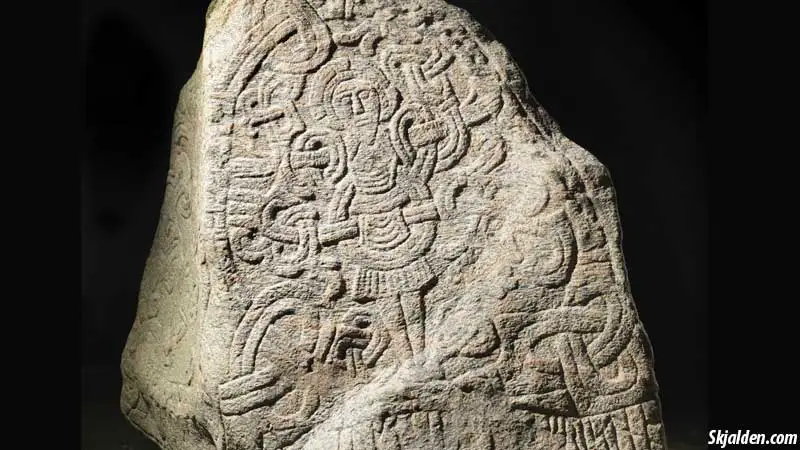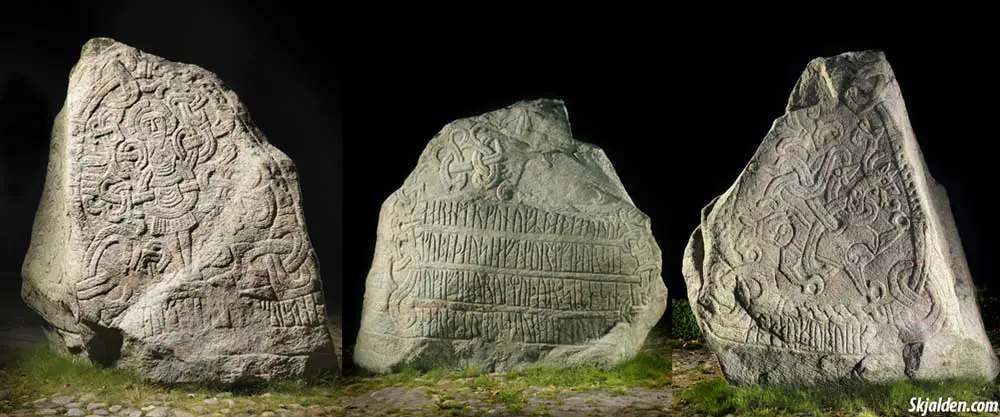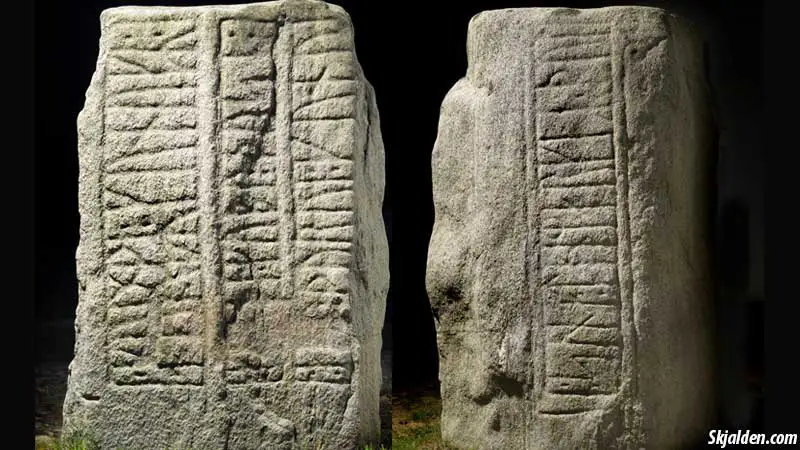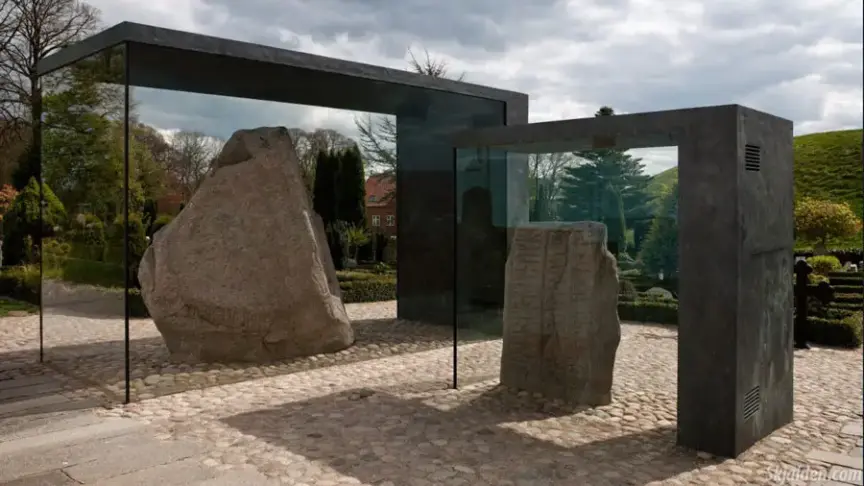The Jelling Stones, a pair of runestones located in Jelling, Denmark, are among the most significant historical artifacts in Viking history. These stones, dating back to the 10th century, are not just ancient relics but also key pieces in understanding the Viking Age and its impact on Europe’s history. Carved with intricate designs and runic inscriptions, they provide a fascinating glimpse into the past, offering insights into the lives, beliefs, and society of the Vikings.
The larger of the two stones was erected by King Harald Bluetooth in memory of his parents, King Gorm the Old and Queen Thyra, and to commemorate his own achievements, including the conversion of the Danes to Christianity. The smaller stone, older and more modest in its design, was raised by King Gorm in honor of Queen Thyra. Together, these stones tell a story of the transition, from the old pagan beliefs to Christianity, reflecting a pivotal moment in Danish history.
Understanding the Historical Significance of Jelling Stones
The Jelling Stones are not merely historical markers but also symbols of the significant cultural and religious shift that occurred in Scandinavia during the Viking Age. The larger stone, often referred to as “Denmark’s birth certificate,” marks the transition from paganism to Christianity. This change was a monumental event in Danish history, signaling the start of a new era. The inscription on the stone is the earliest written record of the name “Denmark,” making it a vital piece of national heritage.
The smaller stone, while less grand in its appearance, is equally important. It symbolizes the earlier Viking Age’s pagan practices and beliefs. The contrast between the two stones provides a clear representation of the cultural evolution that took place during this period.

Artistic and Linguistic Insights
The artistic designs on the Jelling Stones are prime examples of Viking artistry. The larger stone may feature a depiction of Christ, which would make it one of the earliest known representations of Jesus in Scandinavia. If true, this imagery could signify the deep influence of Christianity on Viking art and iconography.
The runic inscriptions on the stones are invaluable for linguists and historians. They offer insights into the Old Norse language, its evolution, and its usage in historical contexts. The inscriptions are among the most detailed from the Viking Age, providing a unique window into the world of the Vikings, their language, and their writing practices.
The Jelling Stones Today: Preservation and Public Interest
The preservation of the Jelling Stones is a priority for historians and archaeologists. Being exposed to the elements for centuries, the stones have undergone conservation efforts to protect them from further erosion and damage. These efforts ensure that future generations can continue to learn from and appreciate these historical treasures.
Research on the Jelling Stones is ongoing. Archaeologists and historians continually study them to uncover more about Viking society, their belief systems, and their interactions with other cultures. Each discovery adds to our understanding of this pivotal era in European history.
Visiting the Jelling Stones
For those interested in Viking history, a visit to the Jelling Stones is a must. The site, now part of a museum, offers an interactive experience for visitors. Through modern technology, visitors can explore the history and significance of the stones in an engaging and informative way. The museum also provides educational resources for those looking to delve deeper into Viking history and culture.
The Jelling Stones remain a focal point for those interested in the Viking Age, attracting scholars, history enthusiasts, and tourists from around the world. Their enduring appeal lies in their ability to connect us to a distant past, offering a tangible link to the lives and stories of the Vikings.

The Large Jelling Stone
| Dating | 965-970 |
| Year of discovery | 1586 |
| Circumstances of discovery | The stone is first mentioned on a now lost tablet from 1586 in Jelling church, referenced by Worm. Jelling 2 was found sunken in the ground where it was erected. |
| Current location | Outside Jelling church, in the middle of the two Jelling hills. |
| Initial dimensions | The stone measures 243 cm above the ground. Maximum width on the inscription side is 290 cm, on the animal side 162 cm, and on the Christ side 158 cm. |
| Inscription | Haraldr kunungR bað gørva kumbl þǿsi æft Gōrm, faður sinn, ok æft Þōrvī, mōður sīna, sā Haraldr es sēR vann Danmǫrk alla ok Norveg ok dani gærði krīstna. |
| Danish inscription translation | Kong Harald bød gøre disse kumler efter Gorm sin fader og efter Thyra sin moder – den Harald, som vandt sig hele Danmark og Norge og gjorde danerne kristne. |
| English inscription translation | King Haraldr ordered these kumbls made in memory of Gormr, his father, and in memory of Þyrvé, his mother; that Haraldr who won for himself all of Denmark and Norway and made the Danes Christian. |
| Translation and case commentary | In the Viking Age, the word “kuml” is only used in the plural when referring to a stone monument consisting of several parts, probably including uninscribed menhirs. In this context, kuml may well refer to the large ship setting, but it is of course impossible to link Gorm’s stone exactly to the other Jelling monuments. The idea that the small Jelling stone stood as a stepping stone in the ship setting is pure wishful thinking. |
| Writing system | The inscription should be read from left to right in horizontal bands. First page A from top to bottom, then page B with the large animal, and finally page C with the *Christ figure. |
| The design of the ornamentation | *Trinity symbols/triquetras on all pages, *the large animal and snake on page B, *Christ figure on page C. *Animal and plant ornamentation. |

The Small Jelling Stone
| Dating | 940-955 |
| Year of discovery | 1586 |
| Circumstances of discovery | The runestone is first mentioned together with The Large Jelling Stone in a prospectus by Rantzau, based on a tablet erected by Caspar Markdanner in 1586. The runestone was probably located by the church door of Jelling church, where it was used as a bench. Around 1600, it is called “Stenen ved dörren liggendis”. However, it appears to have been erected between 1627 and 1639. Its original location cannot be determined, but it most likely belonged to Gorm’s Jelling monument, the ship setting. |
| Current location | Outside Jelling church, in the middle of the two Jelling hills. |
| Initial dimensions | The rune stone is approx. 185 cm high (proven by excavation in 2006), 139 cm measured from ground level to the top of the stone. The width is measured at the widest point of the stone. |
| Inscription | GōrmR kunungR gærði kumbl þǿsi æft Þōrvī, kunu sīna, DanmarkaR bōt. |
| Danish inscription translation | Kong Gorm gjorde disse kumler efter Thyra sin kone Danmarks bod. |
| English inscription translation | King Gormr made this monument in memory of Þyrvé, his wife, Denmark’s salvation/adornment. |
| Translation and case commentary | The translation and interpretation of “Danmarks bod” has been disputed, but is now associated with Thyra (Danmarks bod or Danmarks pryd). *The framing theory, which linked it to Gorm, has been abandoned. It has been debated whether tanmarkaR but means ‘Denmark’s ornament’ or ‘Denmark’s penance’, but recent research (Olsen 2012) suggests that ‘penance’ in the sense of ‘Denmark’s repair, strength or benefit’ is the most likely. |
| Writing system | Parallel arrangement, unidirectional lines starting from the bottom, successive routing from left to right. |
| The design of the ornamentation | Worm heads – previously thought to be spiral ornamentation – complete the double frame lines on either side of the inscription at the top of the B side of the stone. |
